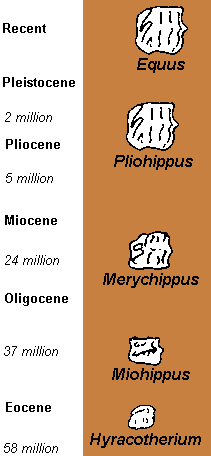Preserving fossils is not easy.
First, the organism must be well buried in a fine silt. Then
that silt must harden while preserving the form of the organism
in order to make a recognizable fossil. Once formed, the fossil
must "survive" millions of years of geological history,
so it must not be crushed beyond recognition, broken to bits or recycled in the Earth's interior. And finally, there
has to be erosion at just the right time in order to expose the
fossil to the searching scientist.
It takes luck
to become a fossil, luck to stay a fossil and luck
to find a fossil!
In spite of these difficulties a few lineages are well represented in the fossil records. These lineages provide important evidence for evolution and also are a great educational opportunity.
One example of a fairly well preserved lineage is that of the
horse.
Thorough 58 million years of sediments we find a fossil record
that shows a tiny dog-size, forest dwelling creature (called
Hyracotherium) becoming a large, grasslands dwelling creature
we call a modern horse (and scientists call Equus).
It takes the training and the keen eye of an experienced anatomist
to identify and analyze fossils and we cannot go into that kind
of detail here, but I'd like to show you two bits of evidence
in horse evolution and explain them to you (briefly).
|
This image represents a hypothetical layer of fossil sediments
(reconstructed from many different fossil sites). The deepest
layers are the oldest and they are overlaid with more recent materials
so prehistory is read from the bottom (oldest) to the top (most
recent). It isn't important to learn the geological times listed
along the side - they are just there to guide you.
I've placed a representative fossil leg in each zone and the name
of the fossil animal from which it came. (Again, don't worry about
the names.) The legs are not drawn
to scale because it would have taken up a lot of space.
The Hyracotherium was a small animal with several toes
on its foot like that of most animals and it lived in the forest.
We know the habitats of fossil animals because fossil plants were
buried with them and give us a clue as to the environment in which
the fossils lived. Over the millions of years the ancestors of
the Hyracotherium evolved into Miohippus and grew
a little larger. (We know that Miohippus was an ancestor
of Hyracotherium due to other fossil evidence that I don't
want to go into.) Miohippus fossils are found among the
fossils of forest and grassland plants. Moving from one
habitat to another puts different demands on the animal and natural
selection started to choose animals from among the population
best suited to grasslands. By the time Miohippus
had evolved into Merychippus it had started to get much
bigger and had evolved the habit of running across the plains.
This put selection pressures to bear on the animals legs. You
need strong, sturdy legs to carry a big animal quickly across
the grasslands.
| 
|
By the time Merychippus had evolved into
Pilohippus, it was very large and very fast. Along the
way, through millions of years of selection pressure, those "horses"
with mutations creating one strong toe to support their heavy
bodies were more successful. Horses with feet poorly adapted
to running, short legs with many toes, just couldn't keep up (evolutionary
speaking) so their fossil remains are no longer found after the
Miocene. In the last few million years Pliohippus evolved
into today's modern horse (Equus).
This fossil record shows how a small forest dwelling animal evolved
into a large animal adapted to its habitat. Take a look at the above image and notice the subtle changes in leg structure that occured during horse evolution.
|
Here's a similar example showing the evolution of horse molars
(back teeth).
These are drawn almost to scale. Notice how the
teeth of Hyracotherium were small and with very few ridges.
That's the teeth of an omnivore, an animal that eats a variety
of food. As the "prehorse" evolved into a grassland
creature it had to eat grass (surprise!) and its teeth evolved
to best handle the coarse, gritty texture of grass. Today's modern
horse has very large teeth well adapted to the heavy chewing required
for an animal living on a diet of grass.
Of course there is much more fossil evidence but I think we will
leave it there.
I hope I have convinced you that there is plenty of evidence to
support Darwin's theory of evolution by means of Natural Selections.
I hope you agree that Paley's theory of Natural Theology (a "designer")
and Lamarck's theory of the Inheritance of Acquired Characteristics
have been disproven by the evidence.
Natural Selection is sufficient for explaining adaptations and a great deal more.
You have completed Lesson 3.
Read through you notes and, when you are ready, go to your self assessment.
Alternatively, you can return to the beginning, take a break and take the self assesment later.
| 
|
This work was created by Dr Jamie Love  and
and  licensed under a Creative Commons Attribution-ShareAlike 4.0 International License.
licensed under a Creative Commons Attribution-ShareAlike 4.0 International License.
If you like, you can return to the Home Page.


 and
and  licensed under a Creative Commons Attribution-ShareAlike 4.0 International License.
licensed under a Creative Commons Attribution-ShareAlike 4.0 International License.